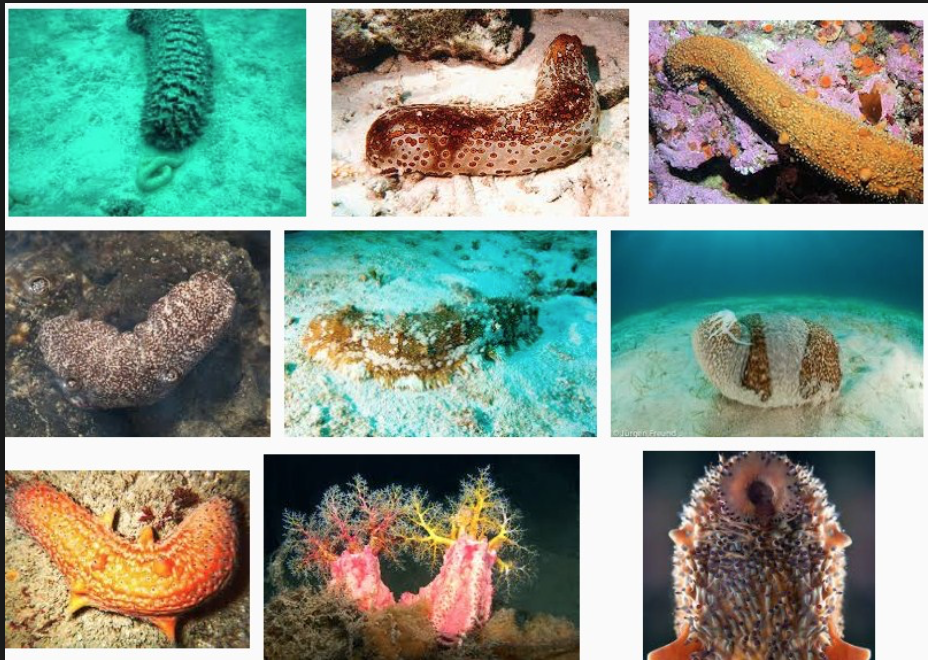
ABOUT SEA CUCUMBERS
Sea cucumbers are echinoderms—like starfish and sea urchins. There are some 1,250 known species, and many of these animals are indeed shaped like soft-bodied cucumbers. All sea cucumbers are ocean dwellers, though some inhabit the shallows and others live in the deep ocean. They live on or near the ocean floor—sometimes partially buried beneath it.
Feeding
Sea cucumbers feed on tiny particles like algae, minute aquatic animals, or waste materials, which they gather in with 8 to 30 tube feet that look like tentacles surrounding their mouths. The animals break down these particles into even smaller pieces, which become fodder for bacteria, and thus recycle them back into the ocean ecosystem. Earthworms perform a similar function in terrestrial ecosystems.
As Prey and Food
Sea cucumbers, particularly eggs and young larvae, are prey for fish and other marine animals. They are also enjoyed by humans, especially in Asia, and some species are farmed as delicacies.
Defensive Adaptations
When threatened, some sea cucumbers discharge sticky threads to ensnare their enemies. Others can mutilate their own bodies as a defense mechanism. They violently contract their muscles and jettison some of their internal organs out of their anus. The missing body parts are quickly regenerated.
Reproduction
Sea cucumbers can breed sexually or asexually. Sexual reproduction is more typical, but the process is not very intimate. The animals release both eggs and sperm into the water and fertilization occurs when they meet. There must be many individuals in a sea cucumber population for this reproductive method to be successful. Indeed, many parts of the deep ocean host large herds of these ancient animals, grazing on the microscopic bounty of marine waters.
Characteristics of sea cucumbers
Unlike other echinoderms, holothurians don't have a distinct radial symmetry but are bilateral (distinct dorsal and ventral side). Holothurians are also called sea cucumbers. As their name suggests, they are cucumber shaped with an elongated, muscular, flexible body with a mouth at one end and the anus at the other. Around the mouth there is a number of tentacles (modified tube feet) used in food collecting. Sea cucumbers come in many sizes, from small species only a few centimeter in length to long snakelike animals which may stretch up to 2 meter!
Ecology and range of sea cucumbers
Rubble, rocks and sand. Also seen on some sponges in large aggregations.
Behavior of sea cucumbers
Most species feed on the rich organic film coating sandy surfaces. The crawl over the bottom ingesting sand. The edible particles (organic matter such as plankton, foraminifera and bacteria) are extracted when passing through their digestive tract and the processed sand is expelled from the anus (as worm-like excrements).
Sea cucumbers move by means of tube feet which extend in rows from the underside of the body. The tentacles surrounding the mouth are actually tube feet that have been modified for feeding.
Other holothurians feed on current-borne zooplankton. They bury in sand extruding their featherlike tentacles (Pseudocolochirus violaceus, Neothyondium magnum or Pentacta crassa). The tentacles have the same shape as soft corals or some anenemones. Large congregations of some small species are found on sponges. They apparently feed on substances secreted by the sponges as well as detritus from the surface.
Some species of holothurians have separate sexes others are hermaphrodites. The sea cucumbers hold on to exposed rocks or corals, raise their body to a upright position, rock back and forth and release the sperm and eggs into the sea.
